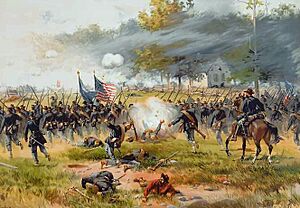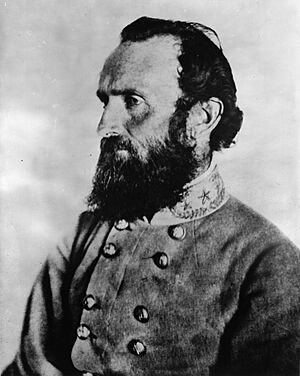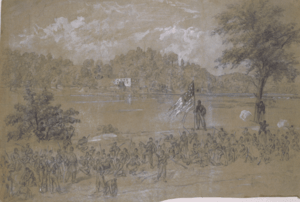Maryland Campaign facts for kids
The Maryland Campaign was a series of important battles during the American Civil War. It happened in September 1862, mostly in Maryland and West Virginia. Confederate General Robert E. Lee led his army into the North. This campaign is also known as the Antietam Campaign.
Lee's main goal was to invade the Northern states of Maryland and Pennsylvania. He hoped to threaten big cities like Washington, D.C. and Baltimore. Lee also believed that if he won big victories, countries like England and France might officially support the South. He thought this could even make President Abraham Lincoln want to end the war. For the Union, this campaign became a major turning point in the war.
Contents
Why the Campaign Happened
In the summer of 1862, the North was losing hope that the war would end quickly. The Union army, led by Major General George B. McClellan, failed to capture the Southern capital of Richmond, Virginia. Soon after, the Confederates won another big battle at the Second Battle of Bull Run. Union soldiers had to retreat back to Washington, D.C.. In the western parts of the country, Confederate attacks were also doing well. This made many Union soldiers feel very discouraged.
Key Battles of the Campaign
General Lee divided his Army of Northern Virginia into smaller groups. He sent three of these groups with General "Stonewall" Jackson to attack Harpers Ferry, West Virginia. Jackson wanted to control the important Shenandoah Valley.
Harpers Ferry (September 12-15, 1862)
The town of Harpers Ferry, West Virginia is located where the Potomac and Shenandoah Rivers meet. It is surrounded by tall cliffs, making it hard to defend. The Union commander there, Col. Dixon S. Miles, kept most of his troops in the town. He did not put them on the higher ground around it.
Jackson placed his cannons on all the high spots and fired at the Union soldiers. Col. Miles decided to surrender his more than 12,000 men. During this time, Miles was badly wounded by a shell and later died. Jackson then took control of Harpers Ferry. He left some soldiers to guard the prisoners and then joined the rest of Lee's army.
South Mountain (September 14, 1862)
This battle happened in Maryland. While part of Lee's army was at Harpers Ferry, the rest moved into Maryland. Major General George B. McClellan's Army of the Potomac was following them closely. The Union army caught up with Lee's forces near Frederick, Maryland.
Fighting began on South Mountain, a natural barrier that separated the Shenandoah and Cumberland Valleys from eastern Maryland. Several smaller battles took place that day to control this mountain. The Confederates were pushed back and lost many soldiers. McClellan could have tried to destroy Lee's army then, but he waited. This gave Lee time to gather his forces again.

Antietam (September 16-18, 1862)
The Battle of Antietam, also called the Battle of Sharpsburg, was the bloodiest single day in American history. Most of the fighting happened on September 17, 1862, between Antietam Creek and the town of Sharpsburg, Maryland.
Something strange happened before this battle. A copy of Lee's secret battle plan (Order No. 191) was found by Union soldiers. It had been used to wrap cigars! This meant McClellan knew exactly what Lee planned to do. However, a Southern supporter told Lee that McClellan had his plans. So, McClellan's advantage was lost.
Because McClellan took his time after the Battle of South Mountain, Lee was able to gather his army near Sharpsburg. The main battles started on the morning of September 16. By evening, neither side had clearly won. Both armies had suffered many losses.
Shepherdstown (September 19-20, 1862)
This battle is also known as the Battle of Botelier's Ford. It took place in Jefferson County, West Virginia. As Lee's army retreated south, Union troops led by Major General Fitz John Porter caught up with Lee's rearguard (the soldiers protecting the back of the army).
While Confederate troops were still crossing the Potomac River, they were attacked. This battle made the Union commanders decide not to follow the Confederate army any further.
About a month later, President Lincoln removed McClellan from command. He was upset that McClellan had not followed and destroyed Lee's army. Major General Ambrose E. Burnside then took over command of the Army of the Potomac.
Images for kids
-
Maj. Gen. Joseph Hooker (I Corps) -
Maj. Gen. Edwin V. Sumner (II Corps) -
Maj. Gen. William B. Franklin (VI Corps) -
Maj. Gen. Ambrose E. Burnside (IX Corps) -
Maj. Gen. Joseph K. Mansfield (XII Corps) -
Maj. Gen. James Longstreet (I Corps) -
Maj. Gen. Stonewall Jackson (II Corps) -
Maj. Gen. J.E.B. Stuart (Cav. Corps)

















